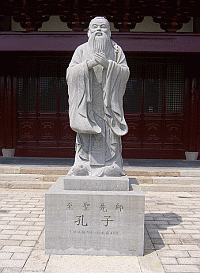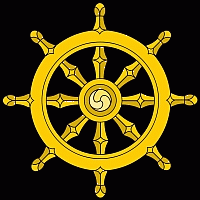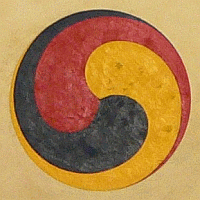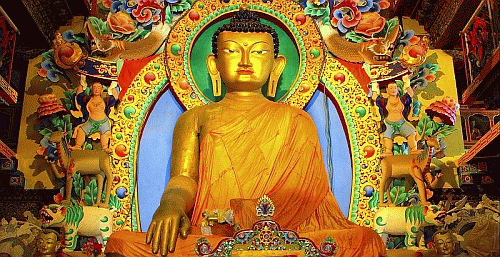|
|
| Buddhism |
Chinese Buddhism
- Introduction
| Buddhism in China is usually traced back to
Confucius (551–479 BC), who is one of the
Country's most renowned philosophers. The name
Confucius is actually a corruption of Master Kong,
and correctly rendered as 'Kung fu zi'. |

Statue of Confucius |
|
| Having spelt his name correctly you will immediately
be struck by the similarity to another world famous
Chinese art: Kung Fu. This is no mistake, as Confucius
was The Kung Fu Grand Master that his name implies |
|
| Kung Fu has many forms and disciplines, and
the well known martial art is but one aspect of
this interesting subject. Kung Fu is also about
medicine - essentially Chinese Medicine, (Healthy
body, soul and mind); peace and harmony with body,
mind and environment; and self-discipline. It
also embodies 'The Ancient Arts' such as Calligraphy
- where wielding pen and sword are regarded as
requiring the same skills. You may not appreciate
the similarities until you witness a Master writing
Chinese characters in a bed of sand using a sword |
|
| The basic teachings of Confucianism stress the
importance of education for moral development
of the individual so that the state can be governed
by moral virtue rather than by the use of coercive
laws. It focuses on human morality and wrong action.
It is a complex system of moral, social, political,
philosophical, and quasi-religious thought that
has had tremendous influence on the culture and
history of East Asia. |
Other related topics include Daoism (Taoism = same thing,
different 'Anglicisation') meaning "path"
or "way", although in Chinese folk religion
and philosophy it has taken on more abstract meanings.
Daoist propriety and ethics emphasize the Three Jewels
of the Dao: compassion, moderation, and humility. Mohism
is best known for the concept of "impartial care"
or "universal love", whilst Legalism (A pragmatic
political philosophy that does not address higher questions
like the nature and purpose of life). However, this
section is not about Kung Fu or Confucius, it is about
Buddhism. So let us end this introduction here and focus
on our main topic.
Buddhism - A Short Historical Introduction
According to the Buddhist tradition, the historical
Buddha Siddhartha Gautama was born to the Shakya clan
in Mithila Kingdom, (563 BC to 483 BC). He is also known
as the Shakyamuni (literally "The sage of the Shakya
clan").
After an early life of luxury, Siddhartha encounters
the realities of the real world and concluded that
life was inescapably bound up with suffering and sorrow.
He renounced his meaningless life of luxury to become
an ascetic. He ultimately decided that asceticism
couldn't end suffering, and instead chose a middle
way, a path of moderation away from the extremes of
self-indulgence and self-mortification.
Under a fig tree, now known as the Bodhi tree, he
vowed never to leave the position until he found Truth.
At the age of 35, he attained Enlightenment. He was
then known as Gautama Buddha, or simply "The
Buddha", which means "the enlightened one",
or "the awakened one".
For the remaining 45 years of his life, he traveled
the Gangetic Plain of central India (the region of
the Ganges/Ganga river and its tributaries), teaching
his doctrine and discipline to a diverse range of
people. By the time of his death, he had thousands
of followers.
What is called Buddhism in the west has been referred
to in India as buddha-dharma meaning: "Path of
Awakening" and thus conforms to a universal understanding
of dharma.
"Dharma" usually refers to the sayings of
the Buddha and to the later traditions of interpretation
and addition that form the various schools of Buddhist
teachings. Alternately, "dharma" may be seen
as an ultimate and transcendental truth
| The Dharma is one of the Three Jewels of Buddhism
of which practitioners of Buddhism seek refuge
in. The three jewels of Buddhism are the Buddha
(mind's perfection of enlightenment), the Dharma
(teachings and methods), and the Sangha (awakened
beings who provide guidance and support). |

The Dharma Wheel |
|
Main Teachings include:
The Buddha's Dharma Body
Six supreme qualities |
|
Some of the fundamental teachings of Gautama
Buddha are:
The Four Noble Truths
The Noble Eightfold Path |
|
| All Buddhists agree that the original turning
of the of the Dharmacakra wheel occurred when
the Buddha taught the five ascetics who became
his first disciples at the Deer Park in Sarnath.
In memory of this, the Dharmacakra is sometimes
represented with a deer on each side. |
| Karma: Cause and Effect |

The Sam Taeguk |
|
| Karma is the energy which drives Samsara, the
cycle of suffering and rebirth for each being.
Good, skillful (Pali: kusala) and bad, unskillful
(Pali: akusala) actions produce "seeds"
in the mind which come to fruition either in this
life or in a subsequent rebirth. The avoidance
of unwholesome actions and the cultivation of
positive actions is called Sila |
|
| In Buddhism, Karma specifically refers to those
actions (of body, speech, and mind) that spring
from mental intent (Pali: cetana), and which bring
about a consequence (or fruit, Sanskrit: phala)
or result (Pali: vipaka). Every time a person
acts there is some quality of intention at the
base of the mind and it is that quality rather
than the outward appearance of the action that
determines its effect. |
Buddhism in China
I am not sure how this began. You see, my problem lies
with the 'Timeline'. At best, Confucius and the First
Buddha were contemporaries; yet recent research confirms
Confucius dates, but puts the First Buddha as being
born shortly after Confucius's death. Yet the two remain
interlinked through Western eyes - or are we looking
in the wrong place?
According to European historians, Mauryan emperor Ashoka
the Great sent royal monk Massim Sthavira to Nepal ,
Bhutan and China to spread Buddhism around 265 BCE.
This is regarded as the beginnings of Buddhist beliefs
in China - yet the fact remains this is more than 200
years after Confucius' death.
Buddhism is derived from early aspects of the Hindu
beliefs of Northern India, as influenced by the Bon
culture of Tibet ... and we already know that another
ancient Tibetan culture preceded these, dating back
to Circa 20, 000 BC
Old Light Through New Windows
One of the Four Great Chinese Epics is entitled 'Journey
to the West'; which you will know simply as 'Monkey'.
The novel is a fictionalised account of the legends
around the Buddhist monk Xuánzàng's
pilgrimage to India during the Táng dynasty
in order to obtain Buddhist religious texts called
sutras. Journey to the West has a strong background
in Chinese folk religion, Chinese mythology and value
systems; plus the pantheon of Taoist immortals and
Buddhist bodhisattvas is still reflective of some
Chinese folk religious beliefs today.
What if...
... this was a real journey that occurred some 1000
years earlier?
I am inclined to favour the year 771 BC as a good place
to start looking, especially if we were to favour the
view that Buddhism spread to India from China; as related
in Journey to the West; or directly from Tibet
We look forward to taking this discourse further,
so see posts in our Forum
for the latest comments, views and information

Buddha Twang
Buddhism in Modern China
Ordinary Chinese people today follow Buddhism and Confucianism,
and treat both as a religion that has its place in their
lives. They embrace qualities we know in the West as
'Chi' or inner power, and will meditate thus. They are
tolerant of Muslims, and find Christianity 'Interesting'.
They are open to theosophical discussions, but will
revert to their traditional family values and Buddhist
beliefs as a norm
In Canton, Buddhism is the religion of virtually all
Chinese. They observe religious holidays and traditions.
They generally accept 3 leading Buddha figures as being
powerful:
• Top Buddha is the guy from India and Hindu extraction
called Amitabha
• Next, and the one worshipped by most in daily
life, is the very great female called Great Mother Buddha,
and akin to the concept of 'Gaia' or Mother Earth
• Common people identify with The Fat Buddha,
known as 'Fa Fa'
Related Pages
• Bon Culture
• Buddhism - This Page
• Confucius
• Legalism
• Mohism
• Taoism / Daoism
• The Swastika
• Buddhist
Breaks in China
• Kung
Fu Breaks in China
|
|
This information is as supplied by Wikipedia, as dated
March 2009 or later, and/or other reliable sources.
Maps (Unless stated otherwise)
are provided in association with Thomas Lessman
Web: www.worldhistorymaps.info
Disclaimer:
Please check this information yourself as it may alter
without notice, and whilst we try our best to ensure
it is correct, please do not hold us responsible for
any errors - this is intended as a simple guide only |
|
| Search
this Website |
|
|
| Our
Friends |

Professional
Visa Services
Company
Formation Packages
.
|
Excellent
& Free Online Chinese Language Portal

Thousands of free print-friendly Chinese reference sheets,
tests and revision aids.
Easy Learning format &
Listen to Spoken Words |

British Foreign Office
Resource and Advice for Travellers Worldwide |

Chinese Embassy in UK
Information About China
International Relations
Visa & Consular |

UK Embassy in China
Information About UK
International Relations
Visa & Consular |

|
Excel
Education |
Languages Courses
Study Abroad
Employability
Summer Camps
Information for Teachers |
|

Excellent and relaxing base to
explore this most beautiful of regions in all China! |
Down The Road.org
How We Traded Our Ordinary Lives For a Global Bicycle Touring Adventure

See
Us in China |

Empowering Underprivileged Children
& Their Communities = Worldwide |
 |

Based in Shangri-la,
Yunnan
Province
Dedicated to Exploring Remote Areas of China
Committed to Nature Conservation and Preserving Ethnic
Cultures & Traditions
|

Based in Xi'an,
China's Premiere Travel Agency and International Travel
Community -
Committed to providing:
Best travel deals & current information for all
International Travellers |

Pearl Dragon
Vast
Online Trading and Information Resource
Link goes to Chinese Tourism and Galleries Section |
|